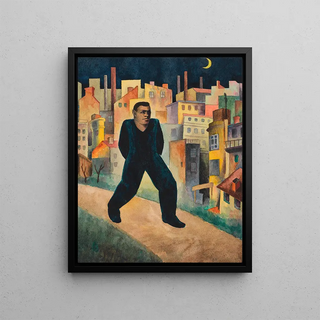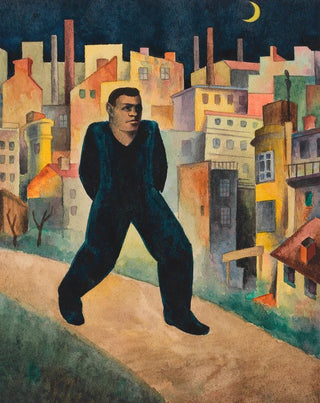Art print | In memory of Trakl - Karl Wiener


View from behind

Frame (optional)
À la mémoire de Trakl - Karl Wiener – Captivating introduction
In the vast panorama of art history, certain works stand out for their ability to evoke deep emotions and provoke reflection on universal themes. "À la mémoire de Trakl - Karl Wiener" fits into this tradition, offering a poignant homage to poet Georg Trakl, whose life and work were marked by a troubling melancholy. This art print invites the viewer to immerse themselves in a universe where beauty and tragedy meet, revealing the layers of a tormented existence. By contemplating this piece, one cannot help but feel the depth of the feelings that animate it, an experience that transcends mere observation to touch the soul.
Style and uniqueness of the artwork
Karl Wiener's work is characterized by a unique stylistic approach that blends figurative and abstract elements. The chosen colors, often dark and nuanced, evoke an atmosphere that is both melancholic and contemplative. The forms, although recognizable, are treated in a way that creates a certain distancing, allowing the viewer to interpret the underlying message freely. The composition of "À la mémoire de Trakl" is carefully orchestrated, with each element harmoniously fitting into a coherent whole. This stylistic choice not only pays tribute to Trakl; it also offers a reflection on the nature of memory and art, questioning our relationship with forgetfulness and cultural heritage.
The artist and his influence
Karl Wiener, an emblematic figure of contemporary art, has established himself through a rich and varied body of work, nourished by his personal reflections and multiple influences. His work is often perceived as a dialogue between the past and the present, a means of exploring the resonances of historical events through the lens of art. The homage to Georg Trakl is not merely a literary reference, but also a way for Wiener to question the place of poetry in our modern world. By incorporating biographical and symbolic elements into his art, he invites the viewer to establish an intimate connection with the work, to reflect on their own memories and

Matte finish

View from behind

Frame (optional)
À la mémoire de Trakl - Karl Wiener – Captivating introduction
In the vast panorama of art history, certain works stand out for their ability to evoke deep emotions and provoke reflection on universal themes. "À la mémoire de Trakl - Karl Wiener" fits into this tradition, offering a poignant homage to poet Georg Trakl, whose life and work were marked by a troubling melancholy. This art print invites the viewer to immerse themselves in a universe where beauty and tragedy meet, revealing the layers of a tormented existence. By contemplating this piece, one cannot help but feel the depth of the feelings that animate it, an experience that transcends mere observation to touch the soul.
Style and uniqueness of the artwork
Karl Wiener's work is characterized by a unique stylistic approach that blends figurative and abstract elements. The chosen colors, often dark and nuanced, evoke an atmosphere that is both melancholic and contemplative. The forms, although recognizable, are treated in a way that creates a certain distancing, allowing the viewer to interpret the underlying message freely. The composition of "À la mémoire de Trakl" is carefully orchestrated, with each element harmoniously fitting into a coherent whole. This stylistic choice not only pays tribute to Trakl; it also offers a reflection on the nature of memory and art, questioning our relationship with forgetfulness and cultural heritage.
The artist and his influence
Karl Wiener, an emblematic figure of contemporary art, has established himself through a rich and varied body of work, nourished by his personal reflections and multiple influences. His work is often perceived as a dialogue between the past and the present, a means of exploring the resonances of historical events through the lens of art. The homage to Georg Trakl is not merely a literary reference, but also a way for Wiener to question the place of poetry in our modern world. By incorporating biographical and symbolic elements into his art, he invites the viewer to establish an intimate connection with the work, to reflect on their own memories and






